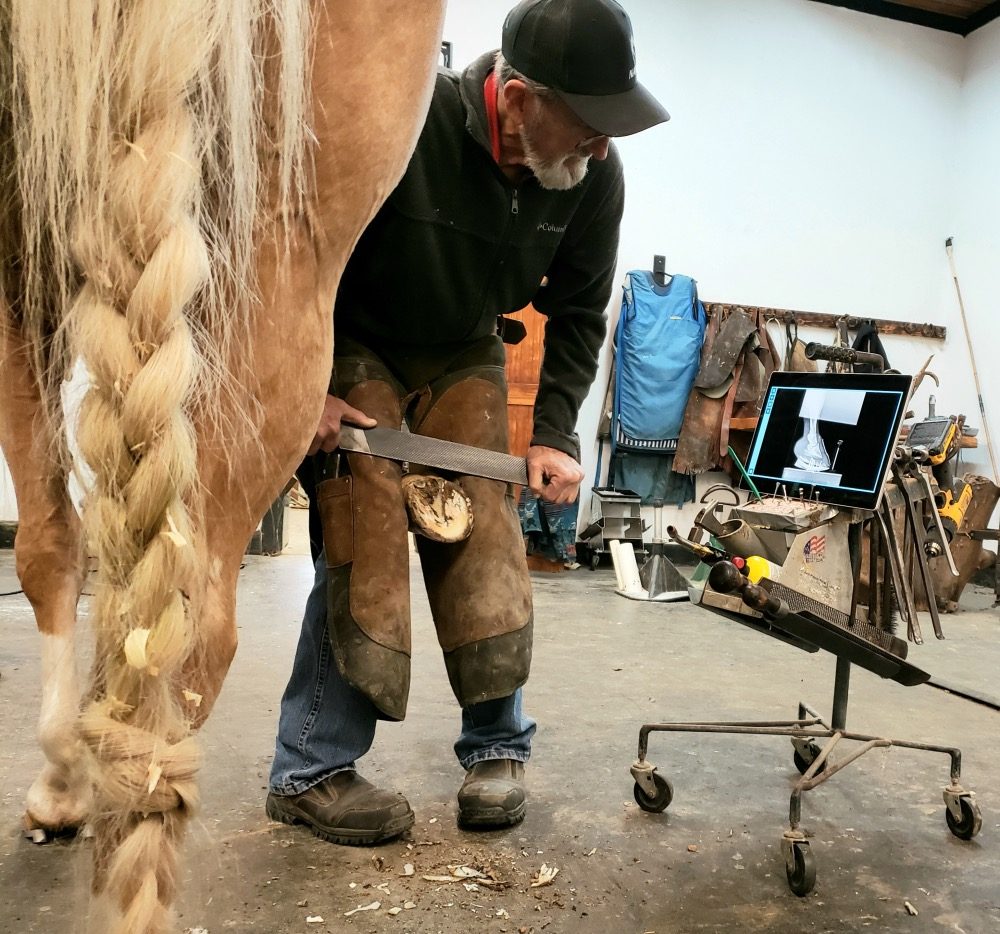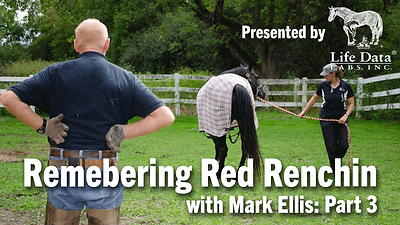Perhaps no other modern practicing veterinarian has made as much of an impact on the equine hoof-care scene as Dr. Ric Redden.
Simply put, the Versailles, Ky., equine veterinarian is an innovator with his creation of the Bluegrass Laminitis Symposium and the International Equine Podiatry Center, as well as the development of many products including the Lily Pad, Modified Ultimate Wedge and Dalric glue-on shoes.
“He has an enormous intellectual curiosity combined with flexibility,” Dr. William Moyer, an equine veterinarian at Texas A&M University said of Redden. “He collects and creates information on a daily basis.”
Redden’s passion for helping the horse is palpable and evident in his work. He is credited with saving the lives of countless horses, including Carolyn Borgert’s mount, which foundered twice.
“Two vets had told me to put my horse down,” says the Vista Hills, Ky., horse owner, “but Dr. Redden saved him.”
The International Equine Veterinarian Hall of Fame member discusses why he has devoted his life to the horse, offers advice for those entering the hoof-care industry and why he returns to the International Hoof-Care Summit year after year.
Q. What interested you in being an equine veterinarian?
REDDEN: I was a farm boy and a member of the richest family in Kentucky; however, we had no money. My dad being crippled in an accident at work in the 1950s inspired me to move swiftly from a child to manhood as I felt responsible and very capable of providing my family of five with a little cash, garden veggies, rabbits, squirrels, fish and a few exotics that I never told anyone what they were.
Our neighbor was very old for me at the time (maybe 50). He took me under his wing and taught me the value of not only working hard but doing it right. We farmed with a team of horses, which was down my alley. Even though the days were long and tiring, I was always excited to catch up the horses in the early morning fog. I would hook my barefoot over the chestnut and pull up with the mane and let them gallop to the barn. I knew I wanted to be a jockey — a Willie Shoemaker or Eddie Arcaro.
One day, we found Mr. Dayton Goins’ big steer down in the creek bed with a broken leg. It looked near impossible to get him up the long steep hill through the woods. My mentor told me it would be a piece of cake. We cut trees for a few hours to make a path, took a barn door down for a sled, backed the team down the hill, rolled the steer onto the door and hobbled him to it. Away we went and the horses were more than eager to get away from the noise behind as I hung onto the steer. It was a wild ride.
Mr. Goins took a rain barrel apart and we were using three of the staves, secured them to the leg with baling wire and left them on for several weeks until the steer could bear weight. I was just entering junior high school and was inspired that day to be a veterinarian and hopefully a jockey.
Neither goal ever left my mind as I learned to ride and care for my horse that I worked a whole year to buy and learned to shoe out of sheer necessity. Then started galloping racehorses at Keeneland and breaking yearlings at numerous farms along with trimming shoeing Tennessee Walking Horses, Saddlebreds, Standardbreds and Thoroughbred racehorses, pulling horses and anything with hair on their back. A 60-foot rope and hobbles were standard equipment for far too many.
Becoming a jockey was still my immediate dream; however, I went from 4 feet, 6 inches tall, weighing 96 lbs. to 5 feet, 6 inches in a years’ time. That didn’t stop me from riding as I to land in Fort Sam Houston in San Antonio, Texas, after being drafted between semesters of college (I had to make enough money to go another year). I became a rider and later farrier for the United States Modern Pentathlon Team, along with managing a farm for Sen. Red Berry. Jerking my weight down from 140 lbs. to 115 allowed me to ride a few races on weekends at the Texas bush tracks.
I worked my way through vet school shoeing on weekends and most evenings. This let me graduate debt-free. Doing all the pathological shoeing for Ohio State University and teaching a basic farrier course to senior vet students set the stage for my desire to share my knowledge, and skills with enthusiastic farriers and veterinarians.
Q. How did you get started in the business?
REDDEN: My background prepared me to face catastrophic situations with an unquenchable desire for success. I started to work in June 1974 for Woodford Animal Hospital in Versailles, Ky. My job was to build a track practice for the clinic. I was just hours from graduating, but I made it happen as I was a race tracker. I knew the people and they knew what I was made of.
In 1975, the cattle business went bust and the clinic asked six of their vets to find other work. I was the first to step up and away I went to the tracks in Kentucky. It was no challenge to find all the lameness work I could handle at two Thoroughbred tracks and two Standardbred tracks every single day of my 10-day week. If you never go to bed the same day you get up, you get 10 days out of the week.
A large part of my lameness practice involved the foot. That was basically no man’s zone for most veterinarians, but very familiar with me and normally not a big deal. My expertise was developing at a rapid rate and I was called to England for a top broodmare. It made all the vets mad because I said, “Hey, this is a piece of cake. You need not kill her.” She had 10 more foals, all winners — seven stakes winners — and voted broodmare of the year on two occasions. I then went to Italy for a foundered, grand old stallion that went on to sire several top horses. For each successful case, I got 10 more to go with it and I loved the challenge.
In 1983, I concluded that I enjoyed my podiatry work far more than the lameness aspect of practice. My wife Nancy and I decided to build the first-ever exclusive equine podiatry clinic and named it International Equine Podiatry Center. Nancy and I sponsored and hosted 20 consecutive Bluegrass Laminitis Symposiums that brought farriers and veterinarians together from all over the horse world and opened the door of opportunity for lasting friendships and teamwork.
Q. What does your practice look like today and how does it differ from when you started?
REDDEN: My practice today continues to consume 12 to 16 hours of my time consulting, teaching and treating a few podiatry cases at the clinic and elsewhere. The pandemic has worked great as a slowdown for me. We are setting up podiatry programs in other locations. Dr. Raul Bras of Rood & Riddle Equine Hospital in Lexington, Ky., and I are instrumental in helping Colorado State University to launch an in-depth podiatry course for veterinary students, as well as farriers. It’s long overdue and time for a change.
Q. What advice do you have for a young person who is starting in the hoof-care industry?
REDDEN: Trimming and shoeing is a learned art that requires several intense years to develop body language, instinctive horsemanship skills and the power of astute observation. There are days we are really tuned in and it seems so easy. Other days, we must think about the task ahead and what our hands must do.
Equine podiatry is a fledgling professional field of public service that is not about shoeing horses nor veterinary medicine, but a unique blend of the two highly respected professions. The focus of podiatry is saving careers and lives. This requires a totally different mindset, education, training, equipment and collaboration skills. This is a whole different ball game as a life can be on the line. Unfortunately, veterinary education and testing do not adequately prepare the student for serious podiatry issues as they get very little, if any, podiatry information during the entire 4 years. Likewise, years of shoeing top-level horses do not prepare a farrier for career and life-threatening problems as it requires radiographic knowledge, interpretation and working knowledge of how the mechanics of trimming and shoeing influence the soft tissue parameters which directly influence blood flow to growth centers and ultimately the ability for the foot to heal.
Podiatry is not about external balance but internal harmony between the forces at play. Adequate working knowledge of the suspension and support components is the basis for the mechanical thought process that sets the stage for the discovery exercise (damage assessment) and subsequent treatment options. Add years of hands-on experience pulling this information together, developing a trimming, shoeing and many times surgical protocol all designed to enhance the blood supply and therefore the healing environment clearly defines the seriousness of podiatry.
This is the new era for vets and farriers that have an unquenchable desire to find success with laminitis and other life-threatening syndromes. Many progressive farriers are eager to start working from the inside out realizing the value of seeing what they can’t see. Many have always had a desire to know precisely how much sole a horse has, the palmar angle (PA), medial-lateral rim and joint balance, bone angle and the digital breakover. They are also starting to buy expensive digital X-ray units and seeking veterinarians who can teach them interpretation skills as it is a no-brainer that it increases their success with difficult cases. It is legal in many states for farriers to own and use them exclusively for trimming and shoe placement. Specific radiographic information is a prerequisite for farriers who accept the responsibility of a pathological foot issue. Otherwise, it’s winging it and success is left to chance.
Set your goals well out of reach and keep stretching until you reach them, then set another and another. Rewrite the book on work ethic, embrace failure with gusto, believe in yourself, believe in God and strive to make others happy. That is success.
Q: Why have you kept returning to the Summit year after year?
REDDEN: The Summit is a great source of information for farriers. The 20 consecutive Bluegrass Laminitis Symposiums helped set the stage for international podiatry education and the birth of the Summit. The Summit’s awesome trade show offers farriers a chance to shop for all the latest innovations and visit with old, as well as newfound friends.








Post a comment
Report Abusive Comment